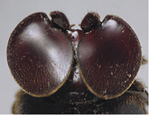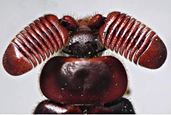

Wendy Moore
California Academy of Sciences
The emerging field of molecular systematics is providing us with powerful new tools to help recover the history of life on Earth. However, one obstacle molecular systematists face is the need to have organisms freshly preserved in 95% EtOH. As soon as an organism dies, its DNA begins to break down. By killing and preserving specimens directly in 95% EtOH, the deterioration of DNA is greatly slowed and large strands of DNA can be recovered from the specimens. Therefore, I would be grateful for any assistance in obtaining paussine specimens preserved for molecular work. I have created the following web page to provide photographs of paussine beetles, in the hopes that colleagues may recognize and preserve specimens in 95% ethanol while in the field.
Information About the Carabid Subfamily Paussinae
Images of the Carabid Subfamily Paussinae
The carabid beetle subfamily Paussinae is one of the two carabid lineages known as "bombardier beetles," due to their ability to synthesize and expel powerful defensive chemicals at ~100°C. This subfamily comprises four tribes: Metriini, Ozaenini, Paussini and Protopaussini. The tribe Ozaenini are free-living predators on arthropods. Ozaenines are generally found running on tree trunks at night, in rotting wood, and under bark. Members of the tribe Paussini are all myrmecophiles, obligate guests of ants, and they have evolved remarkable morphological adaptations to live with these social insects. Paussines have been collected under rocks and from the bark of trees. The Protopaussini, are also assumed to be myrmecophiles but the life history of this group is not well known. Ozaenines, paussines and protopaussines are collected at black lights.
 |
 |
 |
 |
 |
 |
 |
One diagnostic trait of these beetles is a curving cuticular fold in the posteriolateral region of the elytra, known as the Flange of Coanda.
 |
 |
The flange is easier to see in ozaenines than it is in paussines. However, members of the tribe Paussini can easily be recognized by their distinctive, highly modified antennae.
 |
 |
 |
 |
 |
Larvae may be in the same habitats as the adults. All paussine larvae have an "anal disk" composed of modified urogomphi and the tenth abdominal tergite.
 |
 |
 |
| Paussini Plates from Genera Insectorum |
|
Wendy Moore, Ph.D. Phone: (415) 321 8325
|
 |

All images copyright © 2001 Wendy Moore, except detail images of paussine antennae copyright © 2001 David Maddison and dancing paussines copyright © 2001 Hugo Fierros.